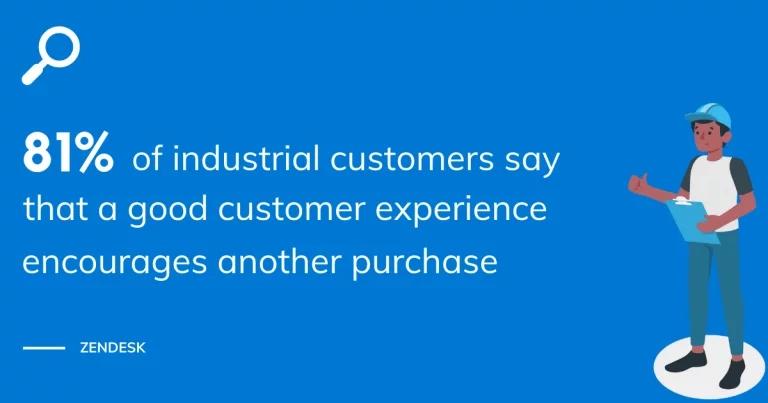The importance of customer service
in the manufacturing industry



The manufacturing sector is facing increasing competition. In these circumstances, focusing only on the products delivered is not a viable strategy for companies in the sector. At the same time, customer satisfaction becomes a new performance driver. For this reason, manufacturers must focus on customer relations. Customer service is an essential component for customer loyalty and company growth. In this article, we propose you to define the customer relationship in the industry, to discover the challenges of the after-sales service and to present you the interest of the visual assistance for the customer support.
The manufacturing sector is ruled by long and complex processes involving highly technical products. For many years, manufacturing companies focused on the product and its manufacture. Efforts were mainly focused on R&D, production, logistics or quality and the customer was often put in the sidelines. However, customer relationship management has become, over time, a subject to be mastered. First of all, because it is 5 to 7 times more expensive to acquire a new customer than to keep one as Dawkins and Reichheld, the famous authors of the book Customer Retention as a Competitive Weapon, explain so well. Secondly, because in the manufacturing sector, the length of a sales cycle is generally longer. Companies have a vested interest in satisfying their current customers and engaging them over the long term.
Moreover, the current context reinforces the importance of customer relations in the industry. Globalization, the constant emergence of new players and the appearance of new technologies and means of communication make it no longer possible for manufacturers to capitalize entirely on their products. Indeed, the increased competition and the multiplicity of offers available on the market make customer retention more and more difficult. Also, the development of digital technology has transformed customers by making them more demanding. They now want personalized experiences, support at all times and quick answers to their problems. Manufacturing companies must therefore pay particular attention to the management of their customer relations if they want to sustain their activities. In the age of Industry 4.0, manufacturers must maximize the availability of their products, the efficiency of their services and, above all, the experience of their B2B customers.

The first step to create a lasting customer relationship is to satisfy the customer with the product. But this is not enough to build customer loyalty over time, as a sale does not stop at the product purchase phase. Manufacturers must therefore look at the total value that a product generates throughout its life cycle. This includes the cost of the product, spare parts, and diagnostic and repair services. A good customer relationship in the industry is thus partly based on the quality of a company’s after-sales service.
After-sales service is the service provided to customers after their purchase. Often reduced to the notion of technical support, after-sales service consists above all of understanding and responding to customer needs of any kind and ensuring customer success. Moreover, in a context where industrial manufacturers tend to move towards “servicization” by offering service subscriptions and not only products, after-sales service plays a crucial role. In the manufacturing industry, the after-sales service can be organized around different missions, such as:
It’s an important service because it represents a company’s values and dedication to its customers. According to a Zendesk study, in the manufacturing sector, 81% of customers say that a good customer experience encourages another purchase. In this context, providing responsive and efficient customer service should be a priority for manufacturers. Moreover, in this type of industry, customer issues are often more difficult to resolve because of the complexity of the products or the magnitude of the consequences. And downtime or machine breakdowns can have a significant impact, particularly in terms of costs and organization. This is why customers expect maximum responsiveness from distributors.

A quality after-sales service allows to maintain the performance of the products as well as to preserve the customer’s trust. But it must also respond to other issues that are just as important for companies, such as:
Customer services in the manufacturing sector face a number of recurring challenges:
Visual assistance is a video communication solution that allows a company to visually access the customer’s problem by sharing its camera. It is a useful tool especially for diagnostics and remote technical support. In addition, remote visual assistance solutions are generally equipped with collaborative features such as remote photo taking, screen sharing or document transfer that facilitate exchanges and problem resolution.

Real-time video is adapted to the problems and challenges of the manufacturing sector. Indeed, video allows to quickly understand the customer’s situation and to give them a quick answer to the problem. The support agents can guide the customer in solving the problem when it is a simple request to solve. This will save you time and money, as you will improve your resolution time and avoid a product return or a technician trip.
If the visual assistance does not solve the problem, the support agent can still make a pre-diagnosis and identify the defective elements. This way, when the technicians intervene, they will be more efficient, because they will already know the reason for the malfunction and will have the right tools to fix it. This allows to optimize the resolution rate at the first intervention.
By using visual assistance, the after-sales service becomes more efficient and its reactivity is boosted. Customers are more satisfied because they save time and money thanks to the reduction of machine downtime. In conclusion, visual assistance helps manufacturers to offer a resolutely innovative and differentiating customer service, guaranteeing customer satisfaction and generating revenue.
Safran Aircraft Engines is a world-class aircraft engine manufacturer that designs, develops, produces and markets engines for civil and military aircraft, and for satellites. Among its services, it offers B.SIde®, a remote assistance solution dedicated to endoscopy. This service puts Safran experts in touch with airline technicians around the world with a single click. By sharing the video stream in real time, technicians are helped in their decision-making during engine borescopies, and can reduce aircraft downtime.

Quality customer service is an effective way to maintain a long-term relationship with customers and to attract new ones. By integrating visual assistance into their services, manufacturing companies improve the after-sales experience. Are you a manufacturing player and interested in visual assistance? Apizee’s solutions are already used by industrial services and can meet your needs. Please contact us to learn more or to receive a demo.
I want to contact an expert I want to see a demo
Read also:
Claire Boscq, CX Activator and founder of JCX Alliance, shares her unique approach to wellbeing-led customer experience. Discover her vision in this new Apizee CX Voices interview.
[CX Industry Voices] Interview with Claire Boscq
25 Jun 2025
Call Centre Helper’s Xander Freeman spoke to Charles Kergaravat, CMO at Apizee, about the rise of video chat in customer service.
The rise of Video Chat in customer service
20 Jun 2025
Simon Macklin from Salesforce, explains how AI and human empathy combine to shape the future of CX. Discover insights in the latest Apizee CX Voices interview.
[CX Industry Voices] Interview with Simon Macklin
19 Jun 2025
Interested in our solutions?